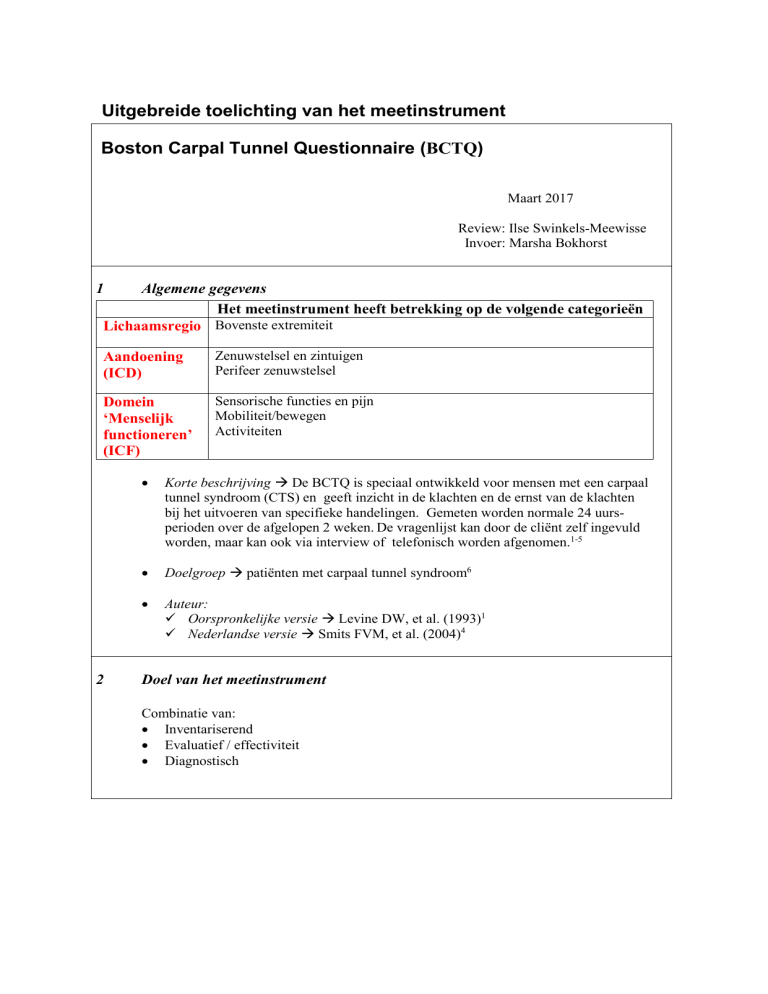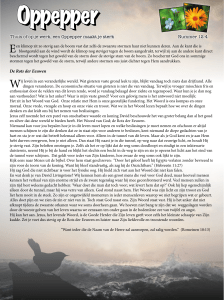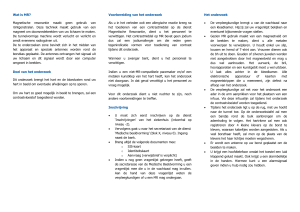
Uitgebreide toelichting van het meetinstrument
Boston Carpal Tunnel Questionnaire (BCTQ)
Maart 2017
Review: Ilse Swinkels-Meewisse
Invoer: Marsha Bokhorst
1
Algemene gegevens
Het meetinstrument heeft betrekking op de volgende categorieën
Bovenste
extremiteit
Lichaamsregio
Aandoening
(ICD)
Zenuwstelsel en zintuigen
Perifeer zenuwstelsel
Domein
‘Menselijk
functioneren’
(ICF)
Sensorische functies en pijn
Mobiliteit/bewegen
Activiteiten
2
Korte beschrijving De BCTQ is speciaal ontwikkeld voor mensen met een carpaal
tunnel syndroom (CTS) en geeft inzicht in de klachten en de ernst van de klachten
bij het uitvoeren van specifieke handelingen. Gemeten worden normale 24 uursperioden over de afgelopen 2 weken. De vragenlijst kan door de cliënt zelf ingevuld
worden, maar kan ook via interview of telefonisch worden afgenomen.1-5
Doelgroep patiënten met carpaal tunnel syndroom6
Auteur:
Oorspronkelijke versie Levine DW, et al. (1993)1
Nederlandse versie Smits FVM, et al. (2004)4
Doel van het meetinstrument
Combinatie van:
Inventariserend
Evaluatief / effectiviteit
Diagnostisch
3
Soort / vorm van het meetinstrument
4
Verkrijgbaarheid
5
Vragenlijst
Opbouw de BCTQ bestaat uit twee delen:
deel 1: Symptom Severity Scale (SSS), 11 items; betreft de ernst van de
klachten
deel 2: Functional Status Scale (FSS), 8 items; meet de belemmering in
uitvoering van specifieke activiteiten4
Invulinstructie bovenaan de vragenlijst staat een korte instructie4
Meetniveau per item: 5-puntsschaal (1-5)4; meetniveau ordinaal
Meetniveau totaalscore: de absolute ernst van de klachten wordt uitgedrukt als het
gemiddelde van alle antwoorden; meetniveau intervalschaal4
Opvraagbaar bij www.meetinstrumentenzorg.nl
Geschatte kosten gratis te downloaden
Copyright ja4
Methodologische kwaliteit
Gegevens over de methodologische kwaliteit staan o.a. in de volgende reviews:
-
Hadi M, Gibbons E, Fitzpatrick R. A structured review of patient-reported outcome
measures for procedures for carpal tunnel syndrome: report to the Department of
Health. 20115
-
De Carvalho Leite JC, Jerosch-Herold C, Song F. A systematic review of the
psychometric properties of the Boston Carpal Tunnel Questionnaire. 20066
-
Hoang-Kim A, Pegreffi F, Moroni A, Ladd A. Measuring wrist and hand function:
common scales and checklists. 20117
Verdere gegevens over de methodologische kwaliteit zijn o.a. te vinden in:
-
Peters-Veluthamaningal C, Winters JC, Groenier KH, Meyboom-de Jong B.
Psychometric properties of a Dutch version of the Boston Carpal Tunnel
Questionnaire. 20098
6
Hanteerbaarheid / feasibility
Taal Engels1, Nederlands (gevalideerd)4, Italiaans3
Benodigdheden invulformulier, pen
Randvoorwaarden geadviseerd wordt de twee delen van de vragenlijst niet apart te
scoren en alleen een totaalscore te gebruiken. Ook wordt
geadviseerd om aan het begin van de vragenlijst aan te geven of
het de linker- of rechterhand betreft.4
Benodigde tijd 2-5 minuten
Gebruikershandleiding bovenaan de vragenlijst staat een korte instructie4
7
Normgegevens
8
Overige gegevens
9
Atrohsi et al. (2009)10 hebben de 11 items ingekort tot 6 items (4 items zijn verwijderd
en 1 item is samengevoegd). De auteurs vonden een goede betrouwbaarheid en
validiteit voor de 6-items CTS Symptom Severity Scale.10
De BCTQ is bekend onder verschillende benamingen: Levine scale, Levine
questionnaire, Brigham and Womens' Carpal Tunnel Questionnaire2, Carpal Tunnel
Syndrome Instrument3, Carpal Tunnel Syndrome Questionnaire5, Boston Questionnaire
(BQ).
Literatuurlijst
1. Levine DW, Simmons BP, Koris MJ, Daltroy LH, Hohl GG, Fossel AH, Katz JN. A selfadministered questionnaire for the assessment of severity of symptoms and functional
status in carpal tunnel syndrome. Journal of bone and joint surgery (Am.). 1993
Nov;75(11):1585-1592.
2. Gay RE, Amadio PC, Johnson JC. Comparative responsiveness of the disabilities of the
arm, shoulder, and hand, the carpal tunnel questionnaire, and the SF-36 to clinical change
after carpal tunnel release. Journal of hand surgery (Am.). 2003 Mar;28(2):250-254.
3. Atroshi I, Johnsson R, Sprinchorn A. Self-administered outcome instrument in carpal tunnel
syndrome: reliability, validity and responsiveness evaluated in 102 patients. Acta
orthopaedica Scandinavica. 1998 Feb;69(1):82-88.
4. Smits FVM, Ottenhof M, R. Feitz R, Kreulen M. Nederlandse vertaling van de ‘Boston
Carpal Tunnel Questionnaire’ voor evaluatie van het carpaletunnelsyndroom (BCTQ-DLV).
Nederlands tijdschrift voor plastische chirurgie. 2014;5(2):70-73.
5. Hadi M, Gibbons E, Fitzpatrick R. University of oxford. A structured review of patientreported outcome measures for procedures for carpal tunnel syndrome: report to the
Department of Health. Oxford: Patient-reported outcome measurement group, University of
Oxford; 2011. Available from:
http://phi.uhce.ox.ac.uk/pdf/Carpal%20tunnel%20review%20FINAL2013.pdf
[Geraadpleegd 2017 maart 21].
6. Leite JC, Jerosch-Herold C, Song F. A systematic review of the psychometric properties
of the Boston Carpal Tunnel Questionnaire. BMC musculoskeletal disorders. 2006
Oct;7:78.
7. Hoang-Kim A, Pegreffi F, Moroni A, Ladd A. Measuring wrist and hand function: common
scales and checklists. Injury. 2011 Mar;42(3):253-258.
8. Peters-Veluthamaningal C, Winters JC, Groenier KH, Meyboom-de Jong B. Psychometric
properties of a Dutch version of the Boston Carpal Tunnel Questionnaire. In: PetersVeluthamaningal C. Corticosteroid injections for the treatment of hand and wrist disorders
in general practice [thesis]. Groningen: Faculteit Medische Wetenschappen,
Rijksuniversiteit Groningen; 2009. Available from:
http://www.rug.nl/research/portal/files/6752991/Peters2010BMCFamPract.pdf
[Geraadpleegd 2017 maart 21].
9. Padua L, Padua R, Aprile I, Caliandro P, Tonali P. Boston Carpal Tunnel Questionnaire:
the influence of diagnosis on patient-oriented results. Neurological research. 2005
Jul;27(5):522-524.
10. Atroshi I, Lyrén PE, Gummesson C. The 6-item CTS symptoms scale: a brief outcomes
measure for carpal tunnel syndrome. Quality of life research. 2009 Apr;18(3):347-358.











